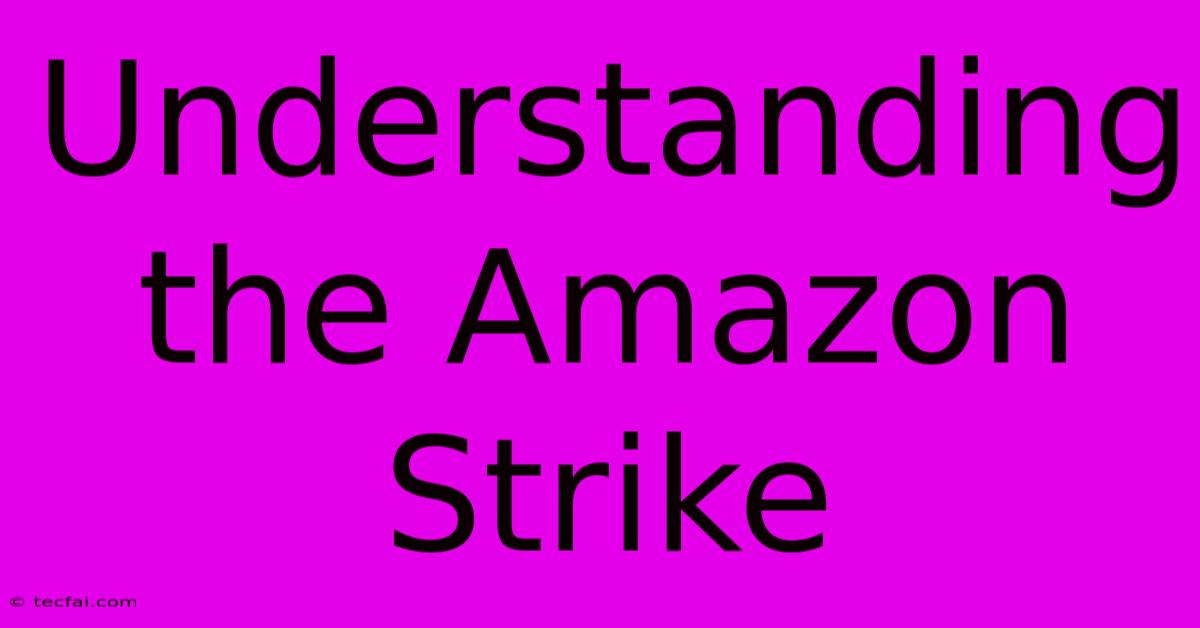Understanding The Amazon Strike

Discover more detailed and exciting information on our website. Click the link below to start your adventure: Visit Best Website tecfai.com. Don't miss out!
Table of Contents
Understanding the Amazon Strike: A Deep Dive into Worker Concerns and Impacts
The recent wave of strikes and protests targeting Amazon highlights growing concerns about worker conditions, fair wages, and the power of tech giants. Understanding the complexities of these actions requires looking beyond the headlines and delving into the multifaceted issues fueling this movement. This article will explore the reasons behind the Amazon strikes, their impact on the company and consumers, and the broader implications for the future of work in the gig economy.
Why are Amazon Workers Striking?
Amazon workers' grievances are numerous and interconnected. While specific demands vary between locations and worker groups, several core issues consistently emerge:
1. Low Wages and Benefits:
Many Amazon employees, especially those in warehouse roles, report earning wages barely above minimum wage, making it difficult to afford housing, healthcare, and other essential needs in areas with high living costs. The lack of adequate healthcare benefits also contributes significantly to financial insecurity.
2. Demanding Work Conditions:
Warehouse work at Amazon is notoriously physically demanding and fast-paced. Employees often face intense pressure to meet unrealistic quotas, leading to high rates of injury and burnout. Reports of inadequate safety measures and insufficient break times further exacerbate these concerns.
3. Lack of Union Representation:
Amazon has a strong anti-union stance, actively working to prevent unionization efforts across its facilities. This lack of collective bargaining power leaves individual workers with little recourse to address their concerns regarding wages, benefits, and working conditions. The absence of a union also limits workers' ability to negotiate for better safety standards and protections against unfair treatment.
4. Algorithmic Management and Surveillance:
The increasing reliance on algorithmic management systems raises concerns about worker autonomy and privacy. Constant monitoring and data collection create a stressful work environment and potentially lead to unfair disciplinary actions.
5. Climate Change Concerns:
Some strikes also incorporate concerns about Amazon's environmental impact, particularly its carbon footprint linked to fast shipping and packaging waste. Workers are increasingly expressing solidarity with environmental movements, advocating for more sustainable practices within the company.
The Impact of Amazon Strikes
Amazon strikes have a ripple effect, influencing several key aspects:
Impact on Amazon:
Strikes disrupt operations, leading to delays in order fulfillment and potential financial losses. Negative publicity surrounding strikes can also damage the company's brand image and affect consumer perception.
Impact on Consumers:
Consumers may experience delayed deliveries and potential disruptions in accessing Amazon services during strike periods. This can highlight the dependence on gig workers and the vulnerability of supply chains.
Impact on the Broader Labor Movement:
Amazon strikes serve as a rallying point for the broader labor movement, inspiring workers in other industries to fight for better working conditions and fair treatment. They demonstrate the potential power of collective action in challenging the dominance of large corporations.
The Future of Work and Amazon's Response
The ongoing strikes represent a significant turning point in the conversation about the future of work, particularly within the gig economy. The issues raised by Amazon workers resonate with many employed in similar precarious jobs. Amazon's response to these strikes will be crucial in shaping the relationship between the company and its workforce, as well as influencing the broader landscape of labor relations in the tech industry. Whether Amazon addresses these core concerns constructively or continues its resistance to unionization remains to be seen. The outcome will significantly impact the lives of thousands of workers and the future of the gig economy itself.
Conclusion
Understanding the Amazon strikes requires acknowledging the complex interplay of economic, social, and political factors. The demands for better wages, improved working conditions, and greater worker rights highlight a crucial debate about fairness, equity, and the power dynamics within the modern workplace. The ongoing struggle for improved working conditions at Amazon will undoubtedly continue to shape discussions about labor practices and the responsibilities of large corporations in the years to come.

Thank you for visiting our website wich cover about Understanding The Amazon Strike. We hope the information provided has been useful to you. Feel free to contact us if you have any questions or need further assistance. See you next time and dont miss to bookmark.
Featured Posts
-
Psl Nuus En Wedstrydresultate
Nov 30, 2024
-
Watch Boise State Vs Oregon State Football
Nov 30, 2024
-
Consumer Advice Homebase Vouchers Ccpc
Nov 30, 2024
-
Pre Register Sa Magic Chess Go Go Gantimpala
Nov 30, 2024
-
2024 Black Friday Deals Live Now
Nov 30, 2024
